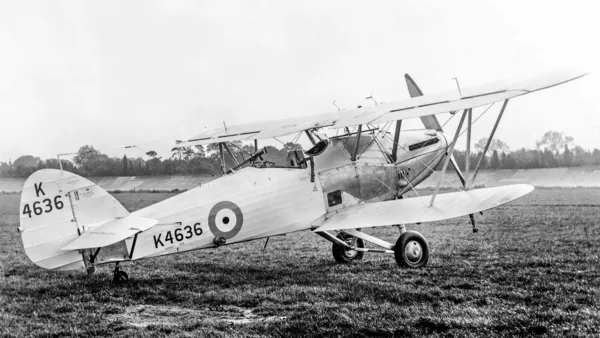Hind (Total: 201, Canadian: 4, Group 0)
Hawker Hind

(Source BAE Systems Web Page)
The HG Hawker Hind was one of the last and among the most successful derivatives of the Hawker Hart.
It was procured against Specification G.7/34 to replace the Hawker Hart itself, whilst operating in very similar roles as a light day-bomber. Its purchase allowed a number of new squadrons to be formed in advance of the arrival of more modern types, such as the Fairey Battle and Bristol Blenheim into RAF service.
In the event, the Hawker Hind was to see service with some 20 RAF Bomber Squadrons and a further seven Auxiliary Air Force Squadrons.
The Hawker Hind used a more powerful version of the Rolls-Royce Kestrel engine, the 640hp Rolls-Royce Kestrel V. The type benefited from an improved bomb-aiming position and a cut-down rear cockpit, similar to that previously adopted on the Hawker Demon. The Hawker Hind was also fitted with revised exhausts and a tailwheel, rather than a tailskid.
The first prototype (K2915) was flown for the first time on 12th September 1934 and was used for a number of trials, prior to the completion of the first production aircraft (K4636), which was flown on 4th September 1935.
The production RAF orders were for batches of 20, 193, 244 and 70 aircraft, totalling 527 aircraft. The Hawker Hind was also successful in the export market, with some 54 aircraft exported to a number of European countries. BAE Systems Web Page
Hind serial A73
s/n A73
as/n L7201
Hawker
A 73
Known Units:
Had been RAF L7201. No previous RCAF history. Received from UK Air Ministry. Reportedly allocated UK Air Ministry training aid number 2229M (but this may be in error), but this is not mentioned in RCAF records.last update: 2025-November-19
1940-May-30 Classified Instructional CA A 73 2020-06-16
1943-April-28 Struck off Strength 2019-08-20
Hind serial A74
s/n A74
as/n K4654
A 74
Known Units:
Had been RAF K4654. No previous RCAF history. Received from UK Air Ministry.last update: 2025-November-19
1940-May-30 Classified Instructional CA A 74 2020-06-16
1943-June-23 Struck off Strength 2019-08-20
Hind serial A75
s/n A75
as/n K8637
A 75
Known Units:
Had been RAF K6837. Built as a light bomber, converted to trainer by General Aircraft. No previous RCAF history. Received from UK Air Ministry.last update: 2025-November-19
1940-May-30 Classified Instructional CA A 75 2020-06-16
1943-October-12 Struck off Strength 2019-08-20
Hind serial A76
s/n A76
as/n K5455
Hawker
A 76
Known Units:
Had been RAF K 5455. Received from UK Air Ministrylast update: 2025-November-19
1943-May-30 Classified Instructional 2023-07-28
1943-June-23 Struck off Strength 2023-07-28